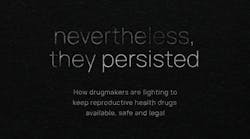At the very least, let's rename QbD "Intelligent Design." That way, columnist Emil Ciurczak quips, we can get faith-based government funding to teach it in U.S. public schools.
For more on Quality by Design and the disconnect with some Pharma H.R. departments read Emil's latest column (posted below for the link-averse):
-AMS
The Perfect Storm*I was perusing the "Positions Available" section of Chemical & Engineering News (just looking, I enjoy not showing up five days a week at the same place) and, as usual, grumbling about the descriptions. One that always gets me is the desire to place an Organic Chemist in charge of an Analytical department. I often see someone in charge of something and comment that I could easily DO the job, but that I could never GET the job. There is a tendency to advertise for the person currently holding a position, not for someone to do a better job. That might prompt a "You're overqualified for the position," from the HR department.
Think about that statement for a second. Were you to need an operation, would you tell a doctor, "No, you've performed too many heart transplants - you're overqualified?" Somehow, I doubt it; but we seem to think chemists, pharmacists and process engineers become worthless when they have experience. Perhaps the quote should be, "No. I think we can find someone to work for less money."
That got me to thinking about our narrow-minded industry. Years ago, while I was at Sandoz, the Colors and Chemicals division moved to South Carolina, leaving a number of employees to seek other positions. Since internal hiring was our practice, I suggested that a woman I knew to be a super chemist submit an application for our section. At the time, I was in the QC department doing my original NIR work (early 1980s). After several weeks, her application had not appeared. When I enquired as to its status, I was told by HR that she didn't have the buzz words, "USP and routine tests" on her resume, so they ignored it.She eventually got the job. She and I worked together and presented several NIR papers"¦but, not because of any help from the HR people. She was to be doing method development and those words don't appear on any QC job description! She was perfect for the job, but couldn't get it. Makes me wonder how we expect QbD and PAT to succeed. Since they are new, there are very, very few job descriptions with those "buzz words" included. Fewer still are resumes with QbD or PAT as accomplishments or goals. As a horse will run back into his burning stall when he panics, so, I fear, will management and HR fall back on "tried and true" (or is that "tired") descriptions and position-filling procedures. One problem with filling a position with someone who has dome nothing but that job is that there is no cross pollination. Since the paradigm has changed with QbD, doing the job the same way with the same personnel"¦well, refer back a few columns to the definition of insanity. I fondly recall the cross-training I received at Ciba in 1970: one week making tablets, one week in sterile products, one week in clinical packaging, etc. When I started my "real" job I had an understanding of where my position fit into the overall scheme of things. While I was tasked with measuring package/product interactions, I had sampled a full-sized V-blender, made my own chewable vitamin C tablets, made pre-formulation compatibility samples for stability testing, and worked with the consumer products (like Binaca breath spray). Do companies take the time to do this cross training anymore? Whence cometh then QbD personnel, prithee?Once more, with my firm grasp of the painfully obvious, I would like to make a simple suggestion. Would it be all that hard to do some cross-pollination within departments? On a larger scale, The Swiss giants (at the time still independent) Ciba, Sandoz, etc. had continuous exchange programs for US and Swiss scientists so that they could familiarize themselves with the other groups within the company. It was much easier to work from another continent when you knew the faces and job skills or your overseas colleagues.Now, extrapolate this to QbD; wouldn't it behoove a Physical Pharmacist, setting parameters for new APIs, to actually work on a compression line and see the potential problems? How about pre-formulation people actually being concerned with real stability issues? One immediate benefit of the cross-training program at Ciba was when a formulator (Glenn van Buskirk, by name) was reformulating a chewable Ritalin tablet. Before he proceeded to stability trials, he asked if the new ingredients might interfere with the current assay. In fact, the red dye (they were cherry-flavored, if I recall) interfered with the colorimetric assay, which developed a red color for spectrometric quantification. His awareness of another department's potential dilemma allowed Analytical R&D to develop a new assay before it was needed.How much better would a QbD program be run if all the members of the committee had a smattering of knowledge of each step in the production of a solid dosage form? Unless we start to work as an organic unit, we may as well break out the slickers and life vests; it's gonna get ugly before the weather breaks.References:*From the book and movie of the same name: implying all (weather, in that case) conditions coming together to wreak more havoc than any one by itself.Latest from Home
Latest from Home





